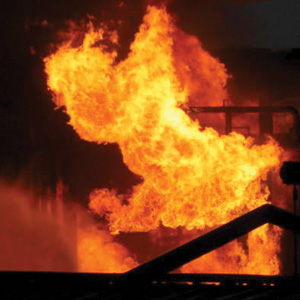“The flames were already billowing out of the windows,” Sr. Insp. Romeo A. Pepito Jr., chief of the Fire Arson Investigation Scene from the Bureau of Fire Protection, recalls. “It was a hopeless case—the firefighters couldn’t do anything anymore. All they could do was to keep the fire from spreading to other houses.”
It was six years ago on March 26, 2005 when that bungalow house located in Lagro, Quezon City burst into flames. When the blaze was fully extinguished about almost two hours later, the charred remains of husband and wife Gerald and Josefina Duque (not their real names), both lawyers, and their two daughters Marie and Abigail (not their real names) who were law students at San Beda College, were discovered in the master’s bedroom and living room, respectively. The rest of the household, including their other four children— Mike, Shiela, Jon and Jeremy (not their real names)—were not home at the time of the fire.
Initial inspection at the site pointed to an accidental fire. However, as the inspection progressed, the arson investigators began to set their eyes on the couple’s eldest, Mike, whose whereabouts were not known at the time of investigation. Moreover, a second look at the scene yielded revelations not seen earlier.
“An upholstered seat and a folding bed blocked the entrance and the exit to the master’s bedroom,” reveals Pepito. “Plus, we found the LPG tank in the middle of the living room. Initially, investigators thought that due to the explosion, the tank could have flown from the kitchen to the living room; but when we measured the distance at 22 meters, that was impossible.”
Investigators next sifted through the debris, and eventually declared the cause of the fire: an electric grill and a fork that was used to puncture the valve of the LPG tank as if to cause a leak. A book, which served as an igniter, was placed on top of the grill. The glass windows of the bungalow house melted, did not crack —a sure sign that someone must have started the fire.
Who would have done such a set up?
Interviews with the victims’ neighbors resulted in more leads. Pepito learned that the day before the fire, the eldest son had gathered newspapers into a heap and set it on fire, perhaps to see how the fire would play out. On the day of the incident, a security guard saw him running away from the burning house with a bag of clothes and a bottle of Gatorade. The guard saw him drop the bottle, pick it up, and run again.
“And he [the eldest son] has a violent streak,” Pepito adds. “At the court, one of the brothers who survived testified that when he didn’t get his way, Mike would burn your shirt or anything you own. One time, Mike even ran after his brother with a butcher knife,” he says, as related in the testimony.
Pepito and his team posted pictures of Mike, who was at large, in all police stations. Within a week, they were alerted that the subject was hiding somewhere in Bulacan. Mike was finally apprehended and just like what the security guard had recounted, he was found holding the bottle.
During the interrogation, Mike was evasive, nonresponsive, and was acting crazy. Pepito’s team got a doctor onboard to check on him, but as what might had been expected, he aced all examinations. It was then that his demeanor suddenly changed—and he asked for a lawyer.
In the end, Mike told the reason for the crime: “His father had their cable TV connection cut off,” Pepito says.
Mike did not end up in jail; instead he was admitted to a mental institution, the case still pending to this day.
The Laws on Arson Cases
The Bureau of Fire Protection responded to 6,781 fire incidents nationwide between January and October of 2010, where 5,067 were found accidental, 163 were suspected arson/intentional, and 1,551 were undergoing investigation. At least 60 arson cases were filed in court.
For fires suspected of arson, four laws apply– Presidential Decrees 1744 and 1613, both issued by deposed President Ferdinand E. Marcos; Revised Penal Code Articles 320 to 326B; and section 10 of the Heinous Crime Act. However, all of these laws have been repealed, except for Presidential Decree 1613 amending the law of arson, which the Bureau of Fire Protection religiously follows.
Presidential Decree 1613 has eight sections. Section I says that whoever burns a house or any structure is penalized with an imprisonment of six years and one day to 20 years. Section II stipulates on destructive arson or that which involves burning a museum, a church or any historical monument, the heaviest penalty for arson cases since not only is the structure burned to the ground but the history or other important documents of the nation as well. Other cases: the burning of an airplane while in flight, a factory for bullets, judicial courts, hospitals, motels and hotels, dormitories, and other public places. Section III includes stipulations on other cases of arson that involve the burning of places that are not thickly-populated such as rice mills, plantations, among others.
Section IV states the special aggravating circumstances on arson—things that can worsen because of arson. What to consider: if there is intent to gain; if committed for the benefit of another; if the arsonist is motivated by hatred or spite; or, if committed by a syndicate.
When death results from arson is what Section V states—life imprisonment for the guilty.
Section VI lays down the prima facie evidence of arson. Examples: if the fire starts simultaneously in more than one part of the building; if substantial amount of flammable material are stored in the establishment; if a number of electrical contrivance are present to start a fire; the building is insured more than its value; and, if shortly before the fire, stuff were pulled out.
Section VII sets out the prescriptions in a conspiracy to commit arson, the penalty of which is life imprisonment. Section VIII stipulates on the confiscation of the object of arson, which states that when a building burns and the owner is proven to be at fault, the whole property, including the lot, is turned over to the government.
ARSON?
“Arson is committed without anyone’s knowledge,” says Sr. Insp. Romeo A. Pepito Jr. “So being an investigator, all I need to do is to dwell on the crime scene. All evidences that I uncover are all circumstantial.”
Pepito shares here some telltale signs of arson.
There should be simultaneous burning. There are some arsonists who start a fire in only one single area, but if you can prove that there are more than two points of origin, then you’ve got an arson case.
Cracks on the wood planks are huge. Accelerants such as an LPG tank may cause huge cracks on wood. But it also depends on the type of wood—hard wood have huge cracks. It is important to study the fire debris closely.
The window pane is melted. In this Quezon City arson case, Pepito and his team found out that the shards melted, which proved that someone started the fire.
The fire is not caused by electricity. “Electricity is a natural heat source,” says Pepito. “Whenever current is flowing in the wire, heat is generated. But when the current goes beyond the allowable capacity of the wire, fire results.” When you can prove that fire is not caused by electricity, and there is no ignition source, then human intervention is a probable reason.
Stuff is pulled out or things get “misplaced.” If the microwave oven is not where it’s supposed to be or an LPG tank is found in the living room, then something is amiss. Or if valuables, electronic devices, furniture were purposefully taken out of the house, as investigators later would find out, then the fire might not be accidental.






